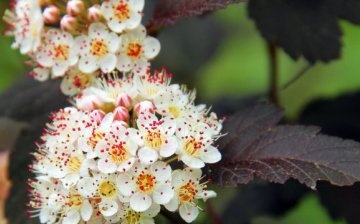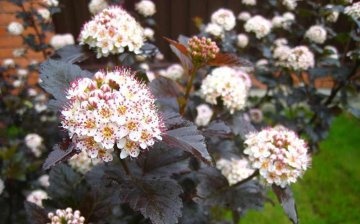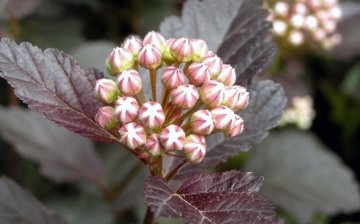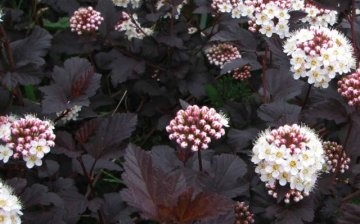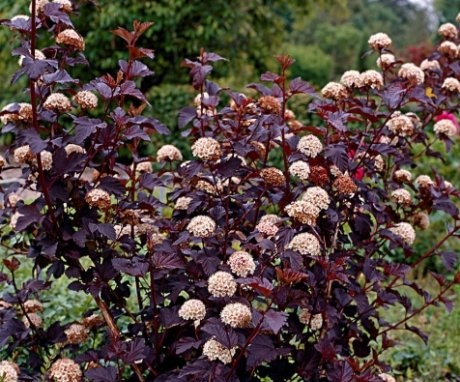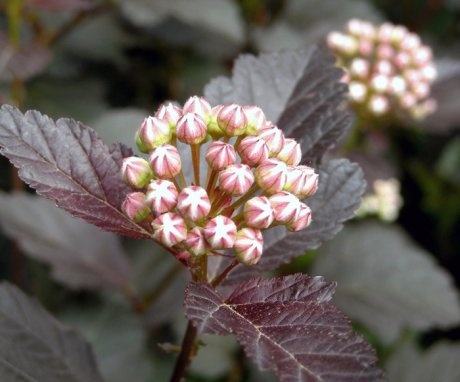Kalinolistnaya spirea - a beautiful and unpretentious shrub
Kalinolistnaya spiraea, it is the kalifolia or meadowsweet bladder, is widely used in landscape gardening. It is beautiful and undemanding to growing conditions.
Content:
- Kalinolistnaya spirea: description, varieties
- Growing conditions and application
- Reproduction and planting
- Shrub Care Tips
Kalinolistnaya spirea: description, varieties
Spirea Kalinolistina in the wild grows along the banks of rivers in North America. The name of the plant, translated from Greek, means a spiral. Probably meant branches spireas, because the flowers do not look like her in any way. There are different opinions regarding the name bladderwort and meadowsweet. Some sources believe that these are different plants.
Spirea Kalinolistnaya is a shrub of the pink family up to 3-4 m high.
Sprawling bush, spherical crown shape. There are a lot of branches, they droop and make the bush thick. The bark is yellow; it peels off on old branches.
The leaves are relatively small, 3-5 lobed, with small denticles, up to 7 cm in size. They are a little like the leaves of the viburnum ordinary, as indicated by its name. The color of the leaves depends on the variety and can be almost any of the possible: from light green, yellowish, to burgundy, scarlet, orange. Spirea sheds leaves for the winter.
Varieties of Kalinolistnaya spirea:
- Diabolo with burgundy foliage, which turns yellow by autumn. The flowers are red, from a distance they look like bunches viburnum... Leaves in the shade can be dark green, turning golden yellow in autumn.
- Diabolo d'Or differs from the mother in the lighter color of the apical leaves. From a distance, it seems that the bush is glowing.
- Luteus (Mod) with leaves, yellow in spring, green in summer. The height of the bush is 2.5 m. This is a hybrid obtained from the Diabolo variety.
- Red Baron 50 cm tall with beautiful corrugated leaves and pink flowers.
- Darts Gold with bright yellow leaves and pink flowers. By autumn, its foliage will turn orange.
- Summer Vine with dark cherry-colored leaves, lots of white-pink flowers. The length of the branches is only 50 cm. The variety was created by crossing the varieties Diabolo and Nanus (a variety that is not particularly noticeable).
- Coppertin is a hybrid variety with orange leaves.
- Andre with bright red top and burgundy bottom leaves.
- Lady in Red with burgundy leaves and pink flowers. The height of the bush is up to one and a half meters.
- Angel Gold with light leaves with a reddish tint.
Kalinolistny spiraea blooms at the end of June. During this period, the bush is covered with large umbrella inflorescences up to 5 cm in diameter with small flowers, white or with a pink tint. The diameter of the flower is only 1 cm. The stamens are red-brown, large. It is they who make the inflorescence fluffy. The bush pleases with flowering for three weeks. By autumn, in place of flowers, red fruits are formed. Over time, they turn brown. The fruits are bubble-shaped leaflets that burst when pressed, emitting cotton. Children like this very much, and they are happy to play with the fruits of the spirea. The bush looks very decorative all year round: in the summer, at the time flowering, in autumn and winter.
The wood is strong, moderately resistant, yellowish, without core. The growth rings are clearly visible. Kalinolistnaya spirea grows for about 50 years.Therefore, having landed it on the site, you can not worry about how to decorate it in order to make it noticeable for several decades.
Growing conditions and application
Spirea Kalifolia is undemanding to the soil. But on fertile, slightly acidic or neutral, it feels better. Does not tolerate stagnant moisture near the roots. Therefore, it should be planted in places where groundwater does not come too close. If there is no other place, provide high-quality drainage. Dislikes spiraea of calcareous soils. It is better not to plant it on them, because there it will be weak and will soon dry out.
Spirea Kalinolistnaya grows well in lighted places - there it blooms more magnificently and brighter.
In the shade, the leaves of the spirea lose their decorative effect. Partial shade tolerates well. Stable spirea to a decrease in temperature, but there is information that in particularly cold winters it can freeze a little. In this case, the bush is cut off, over the summer it grows back and looks beautiful. Most likely a young bush is afraid of the cold. Gardeners say that an adult tolerates temperatures up to 40 degrees below zero.
Kalinolistnaya spirea is not afraid of strong cold winds, smoke and gas pollution in a big city. Therefore, it can be planted in city parks and squares. Suitable for landscaping wastelands due to its unpretentiousness and resistance to diseases and pests.
Shrub Application:
- Spirea is used for the formation of hedges, planted in groups, in solitary or mixed plantings. Hedges usually have strict geometric shapes.
- Looks good near conifers: spruce, pine trees, fir.
- In order to create a bright group in a park or garden, you need to take into account the color of the leaves of different varieties of Viburnolia spirea. By pruning the bushes into different shapes (a cone, a ball, a pyramid or a connection of these shapes), you can create original compositions.
Kalinolistnaya spiraea practically does not get sick, is not damaged by pests. This makes it even more desirable for landscape designers.
Spirea is considered a good honey plant. Bee hives can be installed near her plantings. The wood lends itself well to processing, polishing, but due to its small diameter, it has no industrial value. It is only suitable for making small crafts.
Reproduction and planting
Spirea can be grown from seeds, but there is no guarantee that the plant will have the properties of the mother plant. Spireas of different varieties cross well with each other. So the Diabolo variety, when crossed with varieties with yellow leaves, gives plants with raspberry or scarlet leaves.
You can propagate the spirea bush dividing the bush, layering or cuttings:
- It is better to divide the bush in the spring. Cut it into several pieces with a sharp knife or shovel. Planted separately, watering well before rooting. Then you need to dig in several branches to a depth of 15 cm for layering. Leaves that go underground are cut off. Pinned with a wooden fork and covered with earth. Water it periodically, make sure that the soil above the layers does not dry out. In the fall, after the cuttings take root, they are separated from the mother bush by cutting the branch closer to the bush. They are sheltered for the winter, and planted in a permanent place in the spring.
- It is a little more difficult to grow a spirea from a cuttings. To do this, in the summer, a non-lignified stalk is cut off, treated with a stimulant that promotes root formation. They are planted in coarse sand or sand with peat. They are building a greenhouse for him. It can be a piece of plastic or a plastic bottle with no bottom. Opening the cork, arrange the airing of the cutting. They are sheltered for the winter, and planted in a permanent place in the spring.
In order to acquire a certain kind of spirea, it is best to buy a seedling in a container. This will allow you to prepare a place for the plant and plant it at any time, except for winter. The seedling must be at least 30 cm in height and have 7-8 shoots.
Shrub planting rules:
- The depth of the pit may not be very deep, up to half a meter, because the roots of the Vine-leaved spirea penetrate shallowly.
- At the bottom, drainage is prepared, garden soil mixed with humus and peat is poured.
- The seedling is carefully removed from the pot, placed in the prepared hole. Make sure that the clod of earth is not damaged at the same time.
- The bush is deepened 5 cm deep. This will make the sleeping points wake up and grow.
- Watered with Kornevin's solution, which will help the plant to take root quickly.
If the seedling was purchased with an open root system, it is planted in early spring or autumn, in September. The roots are carefully straightened, sprinkled with prepared soil. Water at least once a week until the plant takes root. After planting, the spirea bush is mulched with peat or a thick layer of mown grass so that the soil under the bush does not dry out. Periodically loosen the soil around the seedling (after watering), remove weeds.
Shrub Care Tips
The beautiful and lush flowering of the Vine-leaved spirea depends on the correct care for it. Although the plant is unpretentious to grow, you need to know some of the nuances:
- It is necessary to water the viburnum spirea only after planting and during dry periods, when the heat reaches 35 degrees. Then water each bush 2 times a week. More often not necessary, because unnecessary watering She does not love.
- Spiraea Kalinolistnaya reacts well to top dressing, which is best done twice a year. In the spring, nitrogen fertilizers are used, which stimulate growth, and in the fall, nitroammofosk. This will help you spend the winter better.
- It is necessary to form a plant from the first years of life. Otherwise, it may turn out that the bush will grow in height, and it will have few side branches. By cutting off the tops of the shoots, they cause the growth of lateral branches.
- If the bush is not pruned further, it will soon look neglected. Pruning carry out sanitary and molding. Broken branches are cut off during sanitary. Although there are usually very few of them. Forming room will help to create a bush of any shape Spirea is not afraid of strong pruning. After her, the bush quickly grows young shoots.
More information can be found in the video:



